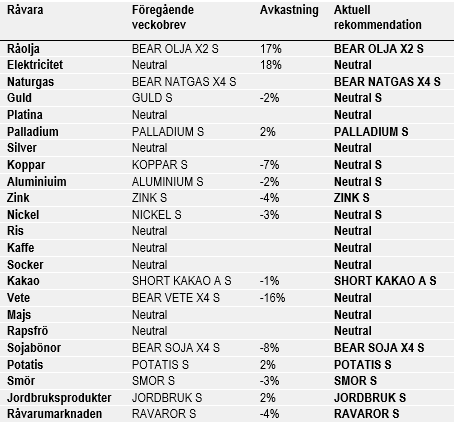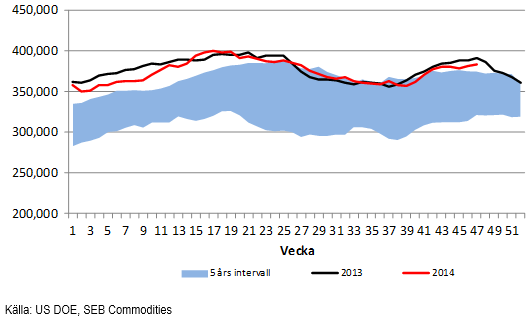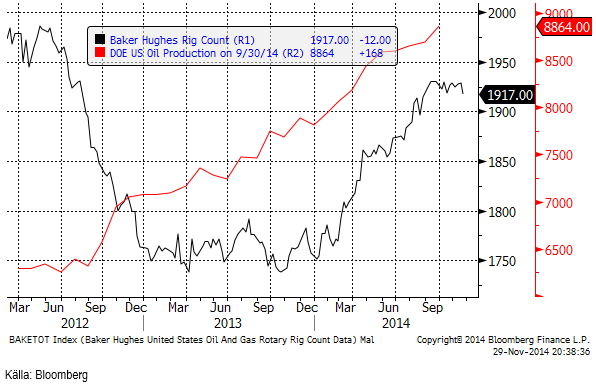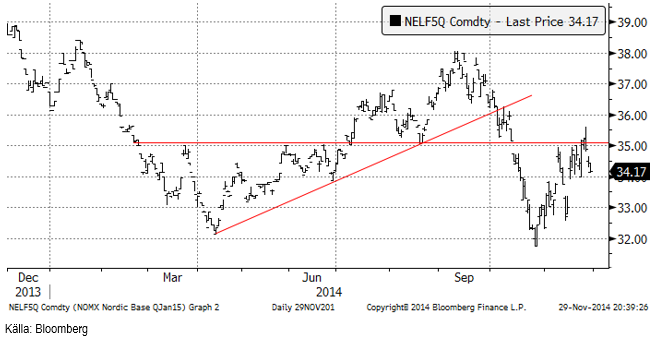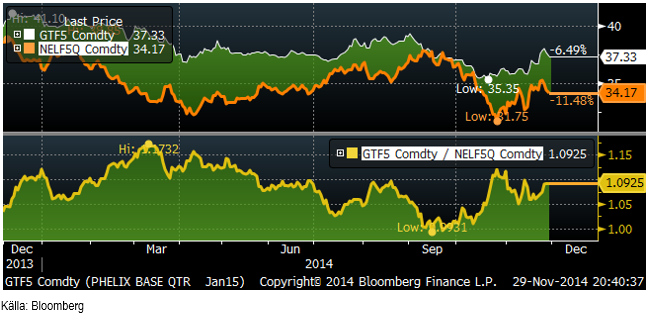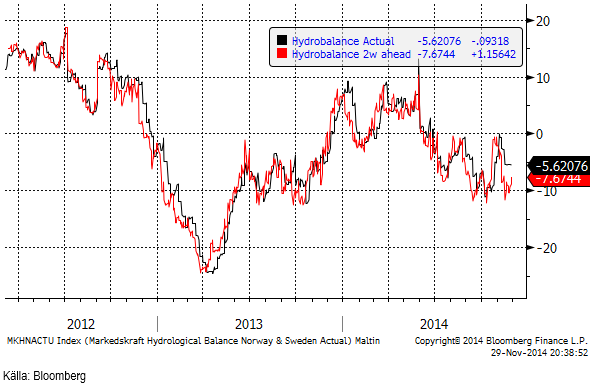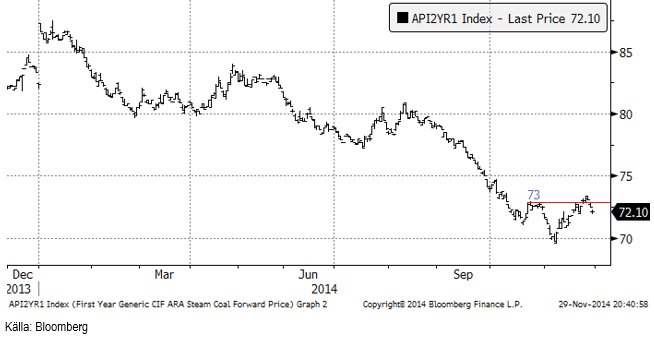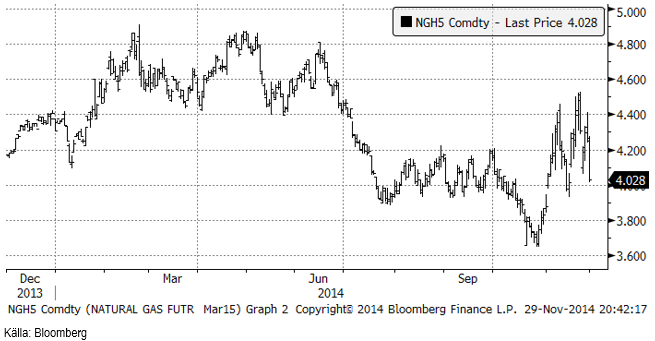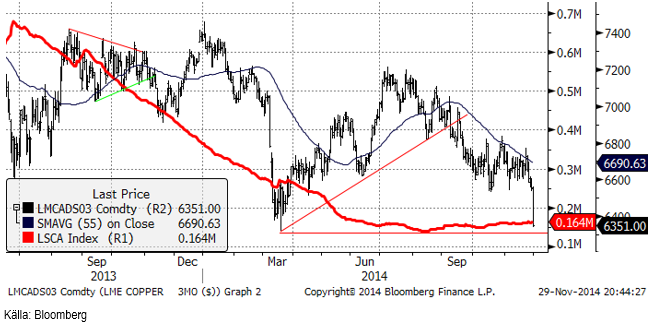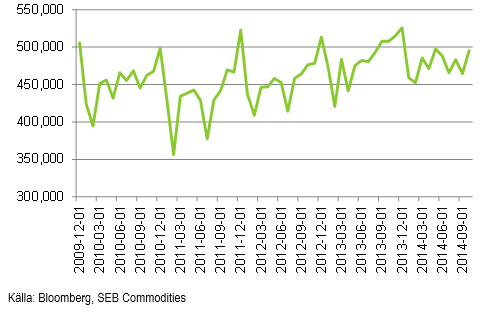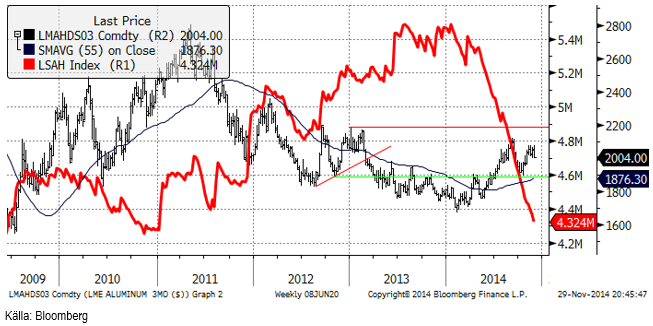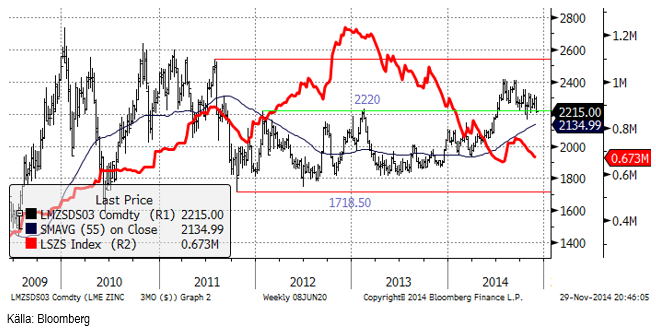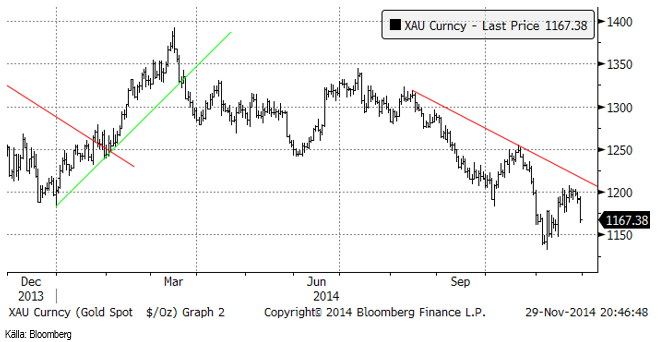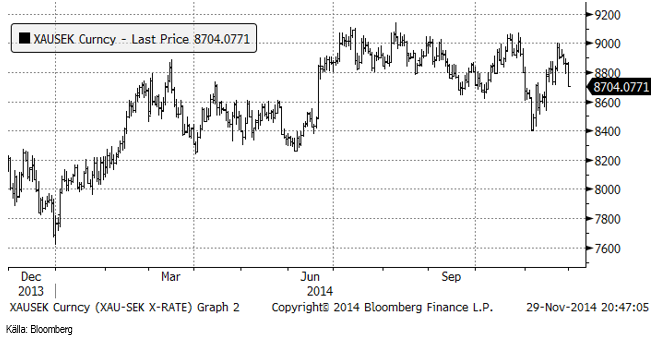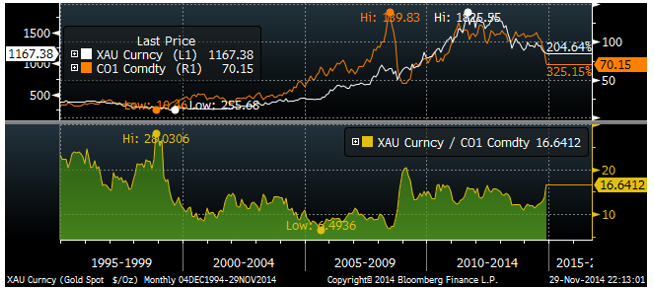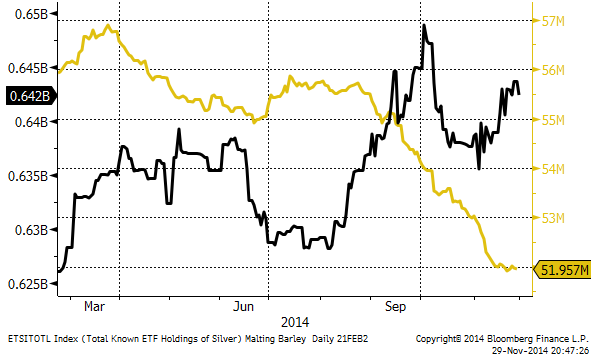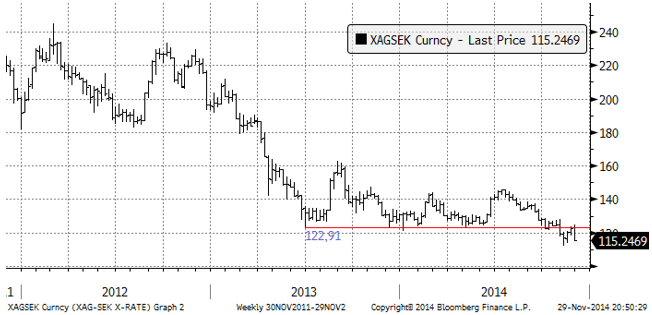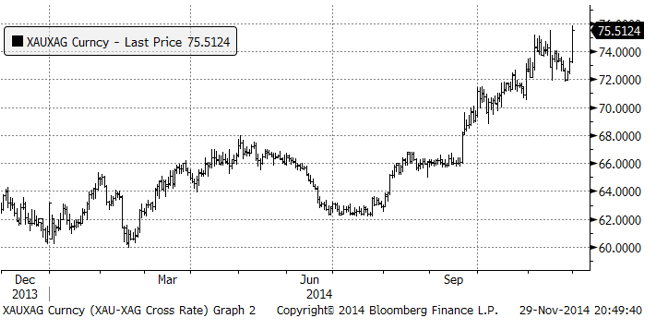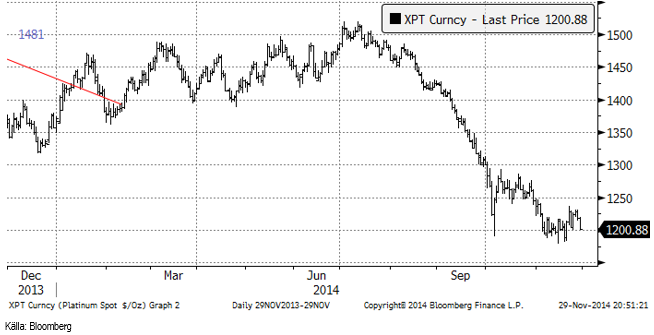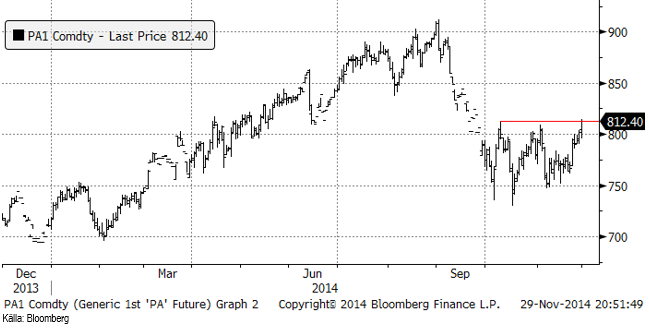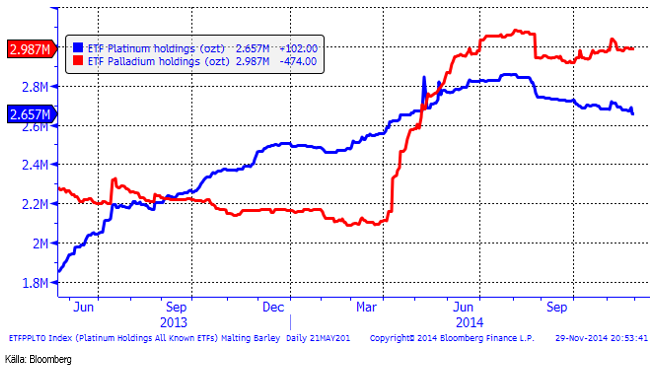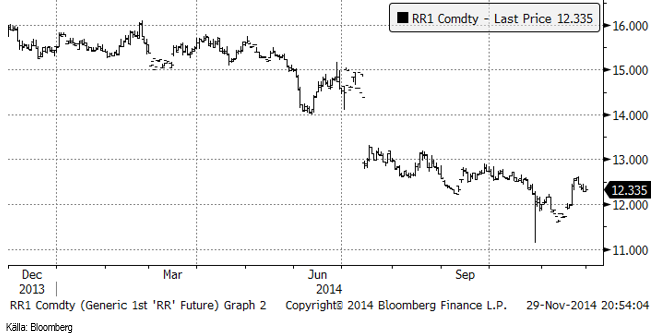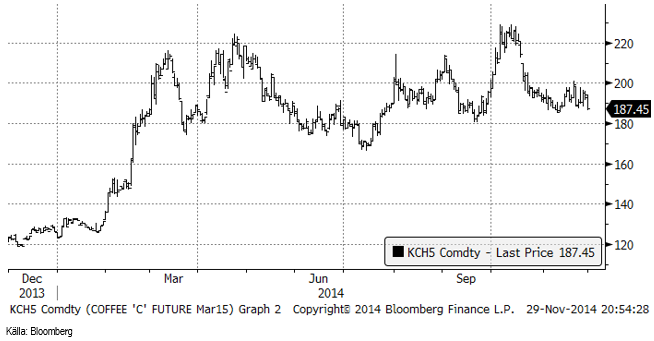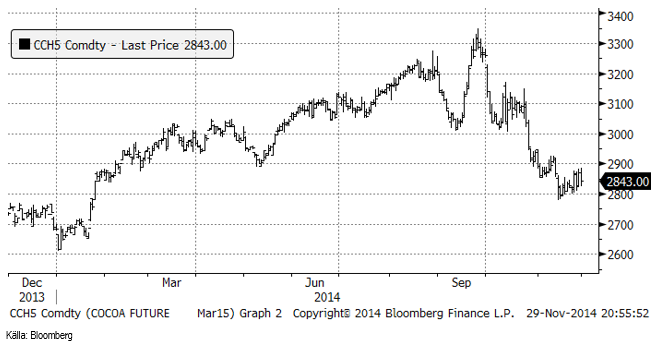Analys
SEB – Råvarukommentarer, 1 december 2014
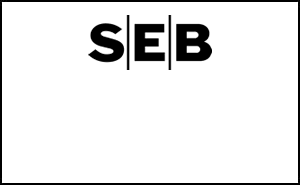
Veckans rekommendationer
Råolja – Brent
OPEC beslutade sig för att inte ändra produktionsmålet på 30 mbpd, vilket läsare av det här veckobrevet inte bör ha blivit förvånade över. Medan det har funnits beskrivningar av beslutet som en blivande seger mot den amerikanska skifferrevolutionen, anser vi att det handlar mer om en klassisk pyrrhusseger.
Som vi har skrivit förut, beror det höga oljepriset på att det är ganska få länder som sitter på lejonparten av konventionella oljefyndigheter. Dessa har över tiden kunnat höja produktionsskatterna, ett bra exempel på economic rent. Skifferfyndigheterna är betydligt mer spridda i världen, vilket gör att föutsättningarna för att tillskansa sig en economic rent försvinner i samma takt som skiffertekniken sprider sig. Sammanhållningen inom OPEC bygger på att var och en håller igen sin produktion till det gemensamma bästa. Den som har fuskat har straffats, framförallt av Saudiarabien, eftersom Saudiarabien haft lediga produktionsresurser. Systemet håller inte när en främmande teknik fått systemet brista och förlora sin mening. Med insikten att det långsiktiga priset är väsentligt lägre, innebär det endast en förlust, utan vinst genom upprätthållande av kartellen, att hålla igen produktionen. Det innebär inte att skifferproducenterna är opåverkade, det är de inte. Men bara det faktum att tekniken finns, gör att OPEC har spelat ut sin roll.
Skiffertekniken är en ung teknik och den utvecklas med ca 30% per år. Nyligen rapporterades att fracking genomförts utan vatten. Istället användes gas, som också återvanns till 100% efter att tryckningen var klar. Invändningen att fracking begränsas pga vattenbrist på många ställen där skifferresurser finns, är alltså borta sedan förra veckan. Det gör att t ex Kina kan börja utvinna sina enorma resurser av skifferolja och skiffergas.
Lagren i USA ökade med 2 miljoner fat enligt DOE:s statistik i veckan.
Nedan ser vi ett diagram på antalet oljeriggar i USA, enligt Baker Hughes statistik (svart). Antalet riggar i drift ökade minskade med 12 till 1917. Det ser ut som om det fallande oljepriset haft en effekt på entusiasmen att borra fler oljekällor i USA.
Vi rekommenderar en kort position, t ex med BEAR OLJA X2 S.
Elektricitet
Priset på elektricitet föll mot slutet av veckan på den nordiska elbörsen Nasdaq Commodities. Varmare och blötare väder kom in i prognosfönstret.
Nedan ser vi kvoten mellan priset på terminen för tysk el under första kvartalet och terminen för nordisk el för samma kvartal. Tysk el har inte fallit i pris på samma sätt under hösten som nordisk el har gjort, utan snarare gått upp något lite.
Hydrologisk balans har enligt 2-veckors prognosen stigit med 1 TWh.
Nedan ser vi terminskontraktet för leverans av kol under 2015, som sjunkit från 72.55 dollar per ton till 72.10 i fredags. Tendensen var svag när handeln stängde för veckan.
Priset på utsläppsrätter steg i veckan från 7 till 7.04, men var uppe på 7.14 som högst.
Naturgas
Naturgaspriset föll kraftigt i fredags i samband med det stora prisfallet på råolja.
Koppar
Priset på koppar föll kraftigt i fredags. Dels påverkade prisfallet på olja negativt. Priset på olja (energi) är en stor del av produktionskostnaden för koppar. Dels visade ny statistik från Chile att produktionen i landet inte minskar, utan istället låg på den högsta nivån på fem månader under oktober.
Chile rapporterade i fredags att landets kopparproduktion uppgick till 495,248 ton i oktober. Det är den högsta nivån på fem månader och visar inga tecken på att reagera på ett lägre kopparpris.
Som vi ser i kursdiagrammet har 3-månadersterminen ännu inte brutit golvet vid 6300 dollar per ton. På COMEX handlas dock koppar lägre än den lägsta noteringen i mars månad, vilket kan utlösa ytterligare prisfall. Vi väljer därför att gå över till neutral rekommendation.
Aluminium
Aluminiumpriset var förbluffande stabilt i veckan, trots att energi är en så stor del av produktionskostnaden och priset på olja föll så kraftigt. Vi tror inte att prisfallet på olja kommer att gå helt obemärkt förbi och väljer därför att gå över till neutral rekommendation.
Zink
Zink föll också pga det lägre oljepriset. Tekniskt har marknaden stöd precis där priset ligger och lagernivån fortsätter att sjunka vid LME. Därför behåller vi köprekommendationen på ZINK S.
Nickel
Nickelpriset föll lav ganska kraftigt i veckan. Nickel används mycket i olje- och gasindustrin. Man kan tänka sig att olje- och gasindustrin i USA går in i ett lite lugnare skede efter oljeprisfallet och det bör tynga nickelpriset. Lagernivån vid LME fortsätter också att stiga, vilket gör att marknaden är känslig för negativa signaler. Vi väljer därför att gå över till neutral rekommendation på nickel.
Guld
Guldpriset lyckades inte bryta 1200 dollar, en psykologiskt viktig nivå eftersom produktionskostnaden för många gruvbolag ligger ungefär där, som marknaden uppfattar genomsnittet för kostnaderna.
I Schweiz folkomröstning att återställa guldreserven i söndags blev det ett rungande ”nej”. Det var i och för sig väntat, men beskedet kan ändå tynga guldpriset lite ytterligare i veckan.
Chartet för guld i kronor visar också fallande pris på veckan.
Prisfallet på olja och det viktiga beslut som (inte) fattades vid OPEC-mötet, fick guldpriset att falla ytterligare. Det finns två anledningar till varför med anledning av oljepriset. För det första ger ett lägre oljepris en kraftig boost för ekonomierna i Tyskland, Frankrike och USA. Det är länder som använder olja för att tillverka andra varor och sälja dem. Vinsterna stiger i näringslivet i dessa länder och det minskar risken för att via inflation behöva inflatera bort skulder. För det andra är kostnaden för olja och annan energi en betydande andel av kostnaden för att producera guld i gruvdrift. Det är djupa gruvor och det är låga halter med mycket malm att krossa för att få fram metallen.
Vi ser kvoten mellan guld och olja nedan. Relationen har alltså stigit ganska kraftigt den senaste tiden och ligger i ett historiskt perspektiv ganska högt. Ytterligare oljeprisfall borde därför dra med sig guldpriset nedåt.
Institutionella investerare äger via ETF/ETC-er 51.96 miljoner uns guld och det är faktiskt mer än de gjorde för en vecka sedan, när de ägde 51.91 miljoner uns. Däremot har de faktiskt netto sålt lite silver.
Vi väljer att gå över till neutral rekommendation på guld.
Silver
Silverpriset vände ner, precis där det i priset i kronor fanns ett starkt motstånd. Vi skrev om det som ett säljtillfälle förra veckan. Silverpriset kommer antagligen att falla ner till en ny årslägsta notering.
Silverpriset i kronor som vi nämnde ovan, vände ner precis vid motståndslinjen. En ny bottennotering är trolig.
Silver nådde en ny bottennivå i relation till guld. Priset på guld i silvertermer nådde med andra ord en ny toppnivå.
Platina & Palladium
Platina föll, liksom guld och silver kraftigt i veckan, ner till 1200 dollar, som för platina fortfarande är en teknisk stödnivå.
Palladiumpriset har stigit från 794.90 för en vecka sedan till 812.40 dollar per uns. Marknaden stängde precis på motståndet, som måste brytas för att marknaden ska få signalen att nästa nivå att testa är 900 dollar. Palladiummarknaden har ett mycket mer positivt beteende än guld, silver och platina och det är inte omöjligt att priset på palladium kan gå upp samtidigt som de andra faller.
Nedanför ser vi hur mycket metall som finns i börshandlade fonder för platina respektive palladium. Investerare har sålt platina och köpt palladium den senaste veckan.
Ris
Priset på ris sjönk i veckan till 12.335 cent per pund.
Kaffe
Kaffepriset (mars) har backat med ett par cent sedan förra veckan. Den brasilianska valutan försvagades i spåren av oljeprisfallet. Djuphavsoljan som varit Brasiliens stora hopp, kostar ca 90 dollar per fat att få upp från 3 km djup under havsytan och den är värdelös vid dagens prisnivå – och den prisnivå som troligen kommer att råda under överskådlig framtid.
Det regnar som vi sett ovan, ganska rikligt över kaffeodlingsområdena i Brasilien. Även detta tynger priset på kaffe.
Vi tror inte att priset går upp. Frågan är när priset börjar falla. Än så länge avvaktar vi med en neutral rekommendation.
Kakao
Kakaopriset rörde sig upp och ner ganska volatilt i veckan. Skörden börjar komma igång. International Cocoa Organization (ICCO) rapporterade i fredags att de väntar sig att överskottet i år blir ännu större än de trott tidigare. Fram till i somras trodde de att skörden skulle bli mindre än konsumtionen. Då ändrade de sig och trodde på ett överskott på 40,000 ton. I fredags justerade de upp överskottet till 53,000 ton.
ICCO estimerar produktionen till 4.37 mt, en höjning från tidigare estimatet 4.35 mt. Samtidigt justerar de konsumtionen till 4.27 mt, även det en höjning från tidigare 4.26 mt.
Skörden i Elfenbenskusten är emellertid långsammare än väntat.
Vi behåller positionen i SHORT KAKAO A S. Nu finns även en BEAR KAKAO X1 S med 1 gånger negativ daglig hävstång och en BEAR KAKAO X4 S med fyra gångers negativ daglig hävstång.
För fler analyser på jordbruksråvaror se SEB jordbruksanalyser.
[box]SEB Veckobrev Veckans råvarukommentar är producerat av SEB Merchant Banking och publiceras i samarbete och med tillstånd på Råvarumarknaden.se[/box]
Disclaimer
The information in this document has been compiled by SEB Merchant Banking, a division within Skandinaviska Enskilda Banken AB (publ) (“SEB”).
Opinions contained in this report represent the bank’s present opinion only and are subject to change without notice. All information contained in this report has been compiled in good faith from sources believed to be reliable. However, no representation or warranty, expressed or implied, is made with respect to the completeness or accuracy of its contents and the information is not to be relied upon as authoritative. Anyone considering taking actions based upon the content of this document is urged to base his or her investment decisions upon such investigations as he or she deems necessary. This document is being provided as information only, and no specific actions are being solicited as a result of it; to the extent permitted by law, no liability whatsoever is accepted for any direct or consequential loss arising from use of this document or its contents.
About SEB
SEB is a public company incorporated in Stockholm, Sweden, with limited liability. It is a participant at major Nordic and other European Regulated Markets and Multilateral Trading Facilities (as well as some non-European equivalent markets) for trading in financial instruments, such as markets operated by NASDAQ OMX, NYSE Euronext, London Stock Exchange, Deutsche Börse, Swiss Exchanges, Turquoise and Chi-X. SEB is authorized and regulated by Finansinspektionen in Sweden; it is authorized and subject to limited regulation by the Financial Services Authority for the conduct of designated investment business in the UK, and is subject to the provisions of relevant regulators in all other jurisdictions where SEB conducts operations. SEB Merchant Banking. All rights reserved.
Analys
A sharp weakening at the core of the oil market: The Dubai curve

Down to the lowest since early May. Brent crude has fallen sharply the latest four days. It closed at USD 64.11/b yesterday which is the lowest since early May. It is staging a 1.3% rebound this morning along with gains in both equities and industrial metals with an added touch of support from a softer USD on top.

What stands out the most to us this week is the collapse in the Dubai one to three months time-spread.
Dubai is medium sour crude. OPEC+ is in general medium sour crude production. Asian refineries are predominantly designed to process medium sour crude. So Dubai is the real measure of the balance between OPEC+ holding back or not versus Asian oil demand for consumption and stock building.
A sharp weakening of the front-end of the Dubai curve. The front-end of the Dubai crude curve has been holding out very solidly throughout this summer while the front-end of the Brent and WTI curves have been steadily softening. But the strength in the Dubai curve in our view was carrying the crude oil market in general. A source of strength in the crude oil market. The core of the strength.
The now finally sharp decline of the front-end of the Dubai crude curve is thus a strong shift. Weakness in the Dubai crude marker is weakness in the core of the oil market. The core which has helped to hold the oil market elevated.
Facts supports the weakening. Add in facts of Iraq lifting production from Kurdistan through Turkey. Saudi Arabia lifting production to 10 mb/d in September (normal production level) and lifting exports as well as domestic demand for oil for power for air con is fading along with summer heat. Add also in counter seasonal rise in US crude and product stocks last week. US oil stocks usually decline by 1.3 mb/week this time of year. Last week they instead rose 6.4 mb/week (+7.2 mb if including SPR). Total US commercial oil stocks are now only 2.1 mb below the 2015-19 seasonal average. US oil stocks normally decline from now to Christmas. If they instead continue to rise, then it will be strongly counter seasonal rise and will create a very strong bearish pressure on oil prices.
Will OPEC+ lift its voluntary quotas by zero, 137 kb/d, 500 kb/d or 1.5 mb/d? On Sunday of course OPEC+ will decide on how much to unwind of the remaining 1.5 mb/d of voluntary quotas for November. Will it be 137 kb/d yet again as for October? Will it be 500 kb/d as was talked about earlier this week? Or will it be a full unwind in one go of 1.5 mb/d? We think most likely now it will be at least 500 kb/d and possibly a full unwind. We discussed this in a not earlier this week: ”500 kb/d of voluntary quotas in October. But a full unwind of 1.5 mb/d”
The strength in the front-end of the Dubai curve held out through summer while Brent and WTI curve structures weakened steadily. That core strength helped to keep flat crude oil prices elevated close to the 70-line. Now also the Dubai curve has given in.

Brent crude oil forward curves

Total US commercial stocks now close to normal. Counter seasonal rise last week. Rest of year?

Total US crude and product stocks on a steady trend higher.

Analys
OPEC+ will likely unwind 500 kb/d of voluntary quotas in October. But a full unwind of 1.5 mb/d in one go could be in the cards

Down to mid-60ies as Iraq lifts production while Saudi may be tired of voluntary cut frugality. The Brent December contract dropped 1.6% yesterday to USD 66.03/b. This morning it is down another 0.3% to USD 65.8/b. The drop in the price came on the back of the combined news that Iraq has resumed 190 kb/d of production in Kurdistan with exports through Turkey while OPEC+ delegates send signals that the group will unwind the remaining 1.65 mb/d (less the 137 kb/d in October) of voluntary cuts at a pace of 500 kb/d per month pace.

Signals of accelerated unwind and Iraqi increase may be connected. Russia, Kazakhstan and Iraq were main offenders versus the voluntary quotas they had agreed to follow. Russia had a production ’debt’ (cumulative overproduction versus quota) of close to 90 mb in March this year while Kazakhstan had a ’debt’ of about 60 mb and the same for Iraq. This apparently made Saudi Arabia angry this spring. Why should Saudi Arabia hold back if the other voluntary cutters were just freeriding? Thus the sudden rapid unwinding of voluntary cuts. That is at least one angle of explanations for the accelerated unwinding.
If the offenders with production debts then refrained from lifting production as the voluntary cuts were rapidly unwinded, then they could ’pay back’ their ’debts’ as they would under-produce versus the new and steadily higher quotas.
Forget about Kazakhstan. Its production was just too far above the quotas with no hope that the country would hold back production due to cross-ownership of oil assets by international oil companies. But Russia and Iraq should be able to do it.
Iraqi cumulative overproduction versus quotas could reach 85-90 mb in October. Iraq has however steadily continued to overproduce by 3-5 mb per month. In July its new and gradually higher quota came close to equal with a cumulative overproduction of only 0.6 mb that month. In August again however its production had an overshoot of 100 kb/d or 3.1 mb for the month. Its cumulative production debt had then risen to close to 80 mb. We don’t know for September yet. But looking at October we now know that its production will likely average close to 4.5 mb/d due to the revival of 190 kb/d of production in Kurdistan. Its quota however will only be 4.24 mb/d. Its overproduction in October will thus likely be around 250 kb/d above its quota with its production debt rising another 7-8 mb to a total of close to 90 mb.
Again, why should Saudi Arabia be frugal while Iraq is freeriding. Better to get rid of the voluntary quotas as quickly as possible and then start all over with clean sheets.
Unwinding the remaining 1.513 mb/d in one go in October? If OPEC+ unwinds the remaining 1.513 mb/d of voluntary cuts in one big go in October, then Iraq’s quota will be around 4.4 mb/d for October versus its likely production of close to 4.5 mb/d for the coming month..
OPEC+ should thus unwind the remaining 1.513 mb/d (1.65 – 0.137 mb/d) in one go for October in order for the quota of Iraq to be able to keep track with Iraq’s actual production increase.
October 5 will show how it plays out. But a quota unwind of at least 500 kb/d for Oct seems likely. An overall increase of at least 500 kb/d in the voluntary quota for October looks likely. But it could be the whole 1.513 mb/d in one go. If the increase in the quota is ’only’ 500 kb/d then Iraqi cumulative production will still rise by 5.7 mb to a total of 85 mb in October.
Iraqi production debt versus quotas will likely rise by 5.7 mb in October if OPEC+ only lifts the overall quota by 500 kb/d in October. Here assuming historical production debt did not rise in September. That Iraq lifts its production by 190 kb/d in October to 4.47 mb/d (August level + 190 kb/d) and that OPEC+ unwinds 500 kb/d of the remining quotas in October when they decide on this on 5 October.
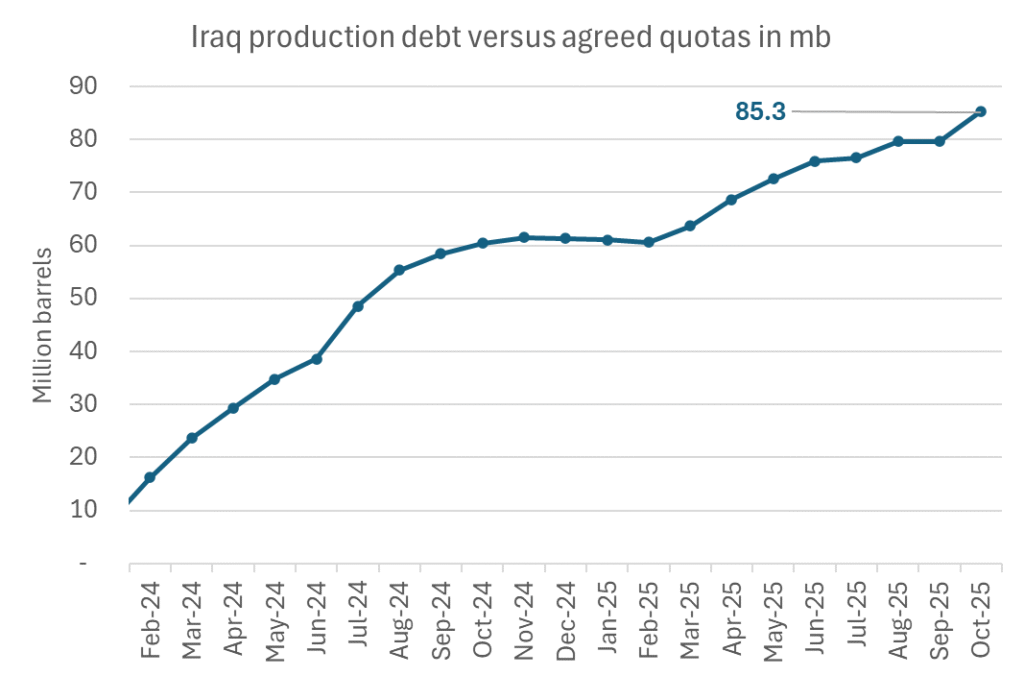
Analys
Modest draws, flat demand, and diesel back in focus

U.S. commercial crude inventories posted a marginal draw last week, falling by 0.6 million barrels to 414.8 million barrels. Inventories remain 4% below the five-year seasonal average, but the draw is far smaller than last week’s massive 9.3-million-barrel decline. Higher crude imports (+803,000 bl d WoW) and steady refinery runs (93% utilization) helped keep the crude balance relatively neutral.

Yet another drawdown indicates commercial crude inventories continue to trend below the 2015–2022 seasonal norm (~440 million barrels), though at 414.8 million barrels, levels are now almost exactly in line with both the 2023 and 2024 trajectory, suggesting stable YoY conditions (see page 3 attached).
Gasoline inventories dropped by 1.1 million barrels and are now 2% below the five-year average. The decline was broad-based, with both finished gasoline and blending components falling, indicating lower output and resilient end-user demand as we enter the shoulder season post-summer (see page 6 attached).
On the diesel side, distillate inventories declined by 1.7 million barrels, snapping a two-week streak of strong builds. At 125 million barrels, diesel inventories are once again 8% below the five-year average and trending near the low end of the historical range.
In total, commercial petroleum inventories (excl. SPR) slipped by 0.5 million barrels on the week to ish 1,281.5 million barrels. While essentially flat, this ends a two-week streak of meaningful builds, reflecting a return to a slightly tighter situation.
On the demand side, the DOE’s ‘products supplied’ metric (see page 6 attached), a proxy for implied consumption, softened slightly. Total demand for crude oil over the past four weeks averaged 20.5 million barrels per day, up just 0.9% YoY.
Summing up: This week’s report shows a re-tightening in diesel supply and modest draws across the board, while demand growth is beginning to flatten. Inventories remain structurally low, but the tone is less bullish than in recent weeks.
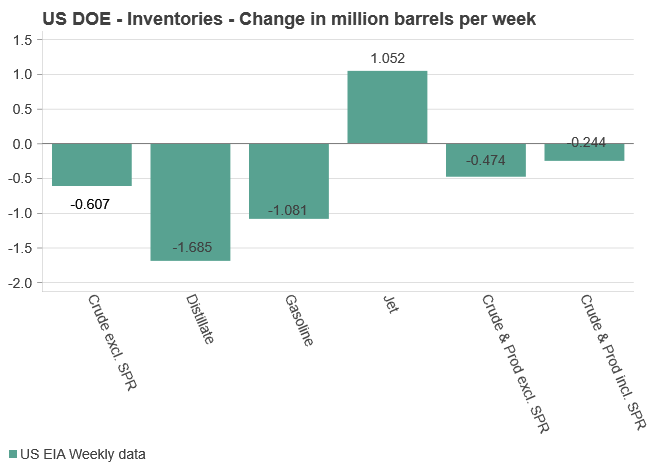
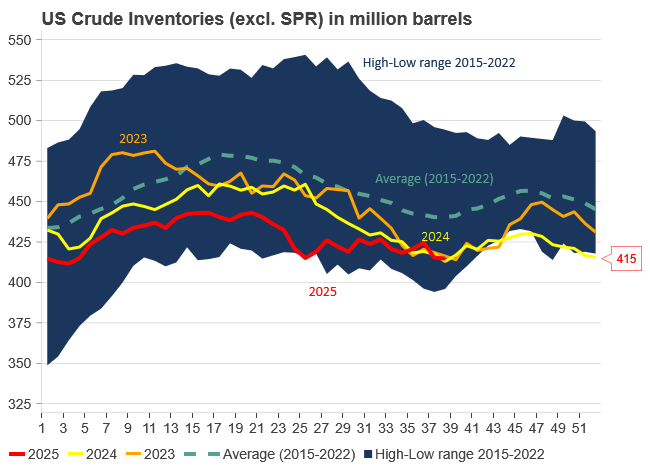
-

 Nyheter3 veckor sedan
Nyheter3 veckor sedanMahvie Minerals i en guldtrend
-

 Nyheter4 veckor sedan
Nyheter4 veckor sedanGuldpriset kan närma sig 5000 USD om centralbankens oberoende skadas
-

 Nyheter4 veckor sedan
Nyheter4 veckor sedanOPEC signalerar att de inte bryr sig om oljepriset faller kommande månader
-

 Analys3 veckor sedan
Analys3 veckor sedanVolatile but going nowhere. Brent crude circles USD 66 as market weighs surplus vs risk
-
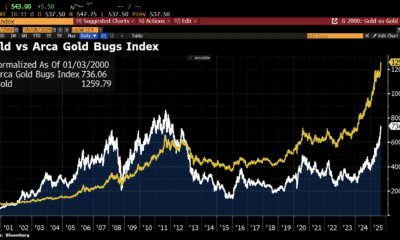
 Nyheter3 veckor sedan
Nyheter3 veckor sedanAktier i guldbolag laggar priset på guld
-

 Nyheter3 veckor sedan
Nyheter3 veckor sedanKinas elproduktion slog nytt rekord i augusti, vilket även kolkraft gjorde
-

 Nyheter3 veckor sedan
Nyheter3 veckor sedanTyskland har så höga elpriser att företag inte har råd att använda elektricitet
-
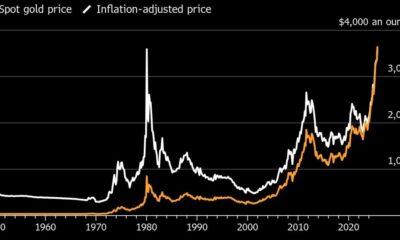
 Nyheter3 veckor sedan
Nyheter3 veckor sedanGuld når sin högsta nivå någonsin, nu även justerat för inflation


